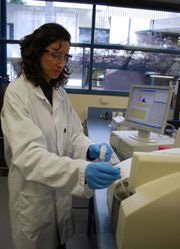Jul 5 2010
A team of researchers at the University of South Australia have developed and patented new technology that allows for enhanced delivery of cosmetics and drugs through the skin.

Dr Nasrin Ghouchi-Eskandar from UniSA’s Ian Wark Research Institute and her team are using nanoparticles of silica (essentially sand) to create longer lasting creams and cosmetics that control the release of drugs through specific layers of the skin.
The researchers are now seeking commercial partners to deliver the technology to market.
Skin creams are made of emulsions – tiny droplets of oily compounds dispersed in water, typically created using surfactants or detergents, but Dr Ghouchi-Eskandar and her colleagues have developed emulsions in which silica nanoparticles coat the droplets instead.
Dr Ghouchi-Eskandar says that the technology allows for greater control over the delivery of drugs through the skin than current methods.
“Coating the tiny emulsion droplets with silica increases the stability of the mixture, and makes it less likely that the active compounds inside will degrade or be released until we want it to happen,” she says. “These are two significant challenges for formulation scientists.”
“Using our method we found that, from a clinical point of view, drug delivery can be improved by adjusting release through the thickness of the coating. We can prepare both fast release, and slow or controlled release delivery systems.”
Dr Ghouchi-Eskandar says that the technology is especially beneficial when a drug needs to be released at a specific time, or if releasing too much at once can lead to accumulation and toxic effects.
“It turns out that silica nanoparticles interact with skin cells in a way that significantly increases the delivery of drugs to specific skin layers,” she says.
“Using nanoparticles, a higher concentration for the active ingredient is delivered and leakage into the bloodstream is limited. This is a great advantage for skin creams like sunscreen, for instance. It limits exposure of the rest of the body and any consequent toxicity.
“We have shown that nanoparticles will not pass through pig skin and in the near future we will be moving to trials using human skin.”
Dr Ghouchi-Eskandar is one of 16 early-career scientists presenting their research for the first time, supported by Fresh Science, a national program sponsored by the Australian Government.